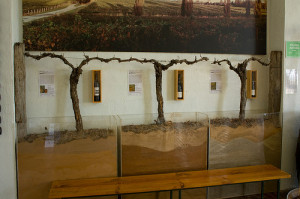The following is a guest post by Gary Strachan, an international vineyard and winery consultant specializing in the start up of vineyards and wineries. Please see his complete bio at the end of this post!
Do you ever have that feeling that no matter what you do it isn’t working? Maybe go back to bed and start the day over? It’s a bit like operating a vineyard. Say it’s been a tough spring and bud break was late. You expect the crop to mature late, especially if you leave too many clusters, so you cluster thin heavily to accelerate ripening. Then you have a perfect summer and the growth in the vineyard looks like a jungle because you didn’t balance it out with a heavy enough crop load.
Murphy’s Law says that “Whatever can go wrong will go wrong, and in the worst possible way.” The point ofthe exercise is to always have a Plan B so that the “worst possible way” is more acceptable.
The best possible Plan B is to do a careful assessment of the site before you plant. This is the only time to choose and modify your terroir. With a good terroir, the vagaries of weather become less severe.
I prefer an eastern exposure because the site warms more quickly in the morning sun and is sheltered from the intense heat of the afternoon. A western exposure can be an advantage in marginal locations where an extra increment of heat is required to ripen long season varieties, but there is also the risk of overheating the vines in the afternoon and suppressing photosynthesis. Exposed red grapes may be heated to the point that the evaporation of flavour compounds exceeds their rate of synthesis on hot days. Picture the problem a plant has to adapt to a daily twenty degree change in temperature.
Slope is important. A 5% slope is enough to provide good air drainage, without creating traction problems. A 30% slope will collect a higher temperature, but is harder to service. Beyond 30% you may have to cope with the inefficiencies of terraces.
If the site is rolling, you must accept that every change in slope will affect fruit composition. There will also be a difference between top, bottom and centre of a slope. Before you plant, decide how important it is to have uniform composition of the fruit from your vineyard. If uniform composition is important, then the top soil should be removed, the site recontoured and the soil profile restored.
While on the subject of soil profile, we should consider how to support healthy roots. Look for well drained soil, hopefully with humus or silt near the surface. If the site has fine soil that drains poorly, then the vineyard must be deep ripped prior to planting. Plants in fine soil should also have assistance to establish by auguring or ditching the planting site and mixing in sharp sand with the fine soil. Be extremely careful with an auger. If you drill in wet clay or silt, you may polish the boundaries of the hole and constrain root growth inside an impenetrable plant pot.
Grapes have a spurt of root growth in spring and again in fall. Prior to bloom they require water at essentially the drained upper limit of soil then gradually less water until veraison. In late summer, when roots have progressively more difficulty to extract water, the root tips begin to release the plant hormone ABA. ABA stimulates the production of phenolic compounds, hardening of the vine, fruit maturation, and suppresses cane elongation. Encourage the roots to seek water but don’t put them into distress. A good soil profile facilitates this. If there is a water barrier or ground water source two or three metres beneath the surface, this is the best of all possible worlds, but it may not be possible in sand or gravel. If you must do a major recontour, consider the composition of sub soil as well as top soil. If your site surface is OK, rip it and leave the profile alone.
One of the major problems that must be adjusted prior to planting is soil pH. If pH adjustment is required, it will take several tons of either powdered limestone or sulphur per acre. After all other operations are completed, the pH adjustment should be tilled into the soil prior to planting, and preferably prior to posting and irrigation installation.
Elevation can be important if it is extreme and results in a shorter growing season, but can be an advantage if it provides good air drainage and good slope and orientation.
The important thing to remember about your terroir is that a good terrior can facilitate maintaining balanced growth in the vineyard in spite of changes in rainfall or temperature from year to year. A good terroir has an exposure that collects more energy than is required on a sunny day but collects enough energy for full growth on an overcast day. The temperature should be moderated by proximity to water. Look around you. A good terroir is beautiful.
This article was first published in British Columbia Fruit Grower and has been republished on this blog with permission from the author.
Gary Strachan is an international vineyard and winery consultant who lives in Summerland, British  Columbia. He is a former Agriculture Canada research scientist who studied cool climate grape varieties and and winemaking. He taught viticulture and enology courses at Okanagan College and Vancouver Island University for over 25 years. He is the former Canadian delegate to the O.I.V. and is current Chairman of BC’s Sustainable Practices Committee. Much of his professional practice is centered on the design and start up of vineyards and wineries.
Columbia. He is a former Agriculture Canada research scientist who studied cool climate grape varieties and and winemaking. He taught viticulture and enology courses at Okanagan College and Vancouver Island University for over 25 years. He is the former Canadian delegate to the O.I.V. and is current Chairman of BC’s Sustainable Practices Committee. Much of his professional practice is centered on the design and start up of vineyards and wineries.
Gary Strachan is listed on LinkedIn.


